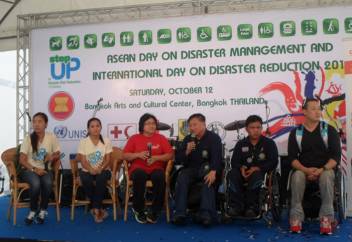 The ASEAN Day for Disaster Management and International Day for Disaster Reduction was celebrated on 12 October in Bangkok, Thailand.
The ASEAN Day for Disaster Management and International Day for Disaster Reduction was celebrated on 12 October in Bangkok, Thailand.
Many organisations came together to commemorate those lives that have been impacted by disasters and to raise awareness of actions that reduce the impact of disasters.
This year’s event focused on advocating for a more inclusive environment for people with disabilities to be involved in disaster preparedness via the theme “living with disability and disaster”.
Many older people live with disabilities
According to the Ageing in 21st Century report, more than 46% of people aged 60 years and over have disabilities, and more than 250 million older people experience moderate to severe disability.
As a result, older people have specific needs in emergency situations, as well as the potential to make great contributions in preventing and recovering from disasters. For example, older people’s experience in coping with disaster risks and climate change can be the key to building resilience within their communities.
The focus of the event was to amplify the critical issue of including the needs of people with disabilities, both now and in the post-2015 framework for disaster risk reduction. I had a chance to share and talk with people living with disabilities about how I have seen older people as great contributors in disaster preparedness. It was a great privilege for me to be part of this event and impart my knowledge of working with older people in the field.
Wall of resilience
At the event, one of the activities that caught my eye was the wall of resilience where people could write notes on their commitment to disaster management or innovative ideas on how we can build safe communities. Many people stopped at the wall to write a message and shared their pledges via social media. For example, one message said “Man made disasters can be more damaging than natural disasters.”
Another popular activity was conducted by HelpAge’s partner in Thailand, FOPDEV which simulated ageing. Participants wore gloves (to reduce their sense of touch), put cotton balls in their ears (to reduce their hearing) and wore glasses with tape inside (so that people couldn’t see clearly). Then participants attempted to thread beads onto a string. The aim of the game was to make participants understand how older people feel and share their concerns about getting older.
Striving for an inclusive society
HelpAge and its partners believe that older people can be effective and useful in contributing to disaster preparedness. Together with older people, we work to ensure older people are included in humanitarian work, policies and resilience efforts.
Building resilience through capacity building with older people is the key factor for them to take a lead in disaster risk reduction. From my experience working with older people in the Philippines, they are useful partners in disaster preparedness if they have the chance to contribute their knowledge.
My experience at this event has built my knowledge on advocating more for disaster management and widening my perspective on the greater issues of social inclusion, including older people and people with disabilities. Now I am even more motivated to work with others to include older people and other vulnerable groups and strive for a more inclusive society.
Find out how HelpAge supports older people in emergencies.
